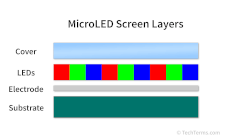MicroLED
Stands for "Micro Light Emitting Diode."
A microLED screen is a type of flat-panel display that uses an array of LEDs to create an image. Each pixel combines three microscopic RGB diodes capable of lighting themselves, eliminating the need for a separate backlight. Since each pixel can be brightened, dimmed, or turned off independently, microLED screens can offer significantly better contrast levels than LCD screens.
MicroLED screens have several advantages over other flat-panel display technology like LCD and OLED. They are much thinner, consisting of only four layers of material. They require less energy since the LEDs are very energy-efficient. Since individual diodes can be turned off, microLED screens have the high contrast and deep black levels of OLED screens; however, the LEDs used can get significantly brighter than those in OLED screens and are not susceptible to screen burn-in. MicroLED screens are flexible and can bend and curve around surfaces. They are also modular, allowing smaller panels to be combined after production to create larger panels in a variety of shapes.
The primary drawback of microLED screens is their extremely high cost, resulting from the complexity of reliably producing individual diodes at microscopic sizes. As of 2022, microLED screens are not yet commonly made for the consumer market; most microLED screens are both too large for comfortable use as a television or computer monitor and prohibitively expensive for most people. MicroLED technology is instead mostly used in commercial settings and the motion picture industry as components of virtual sets.
How MicroLED Screens are Made
A microLED screen has just four layers of components that make up the display, resulting in a thinner and lighter screen than other kinds of flat-panel. These layers include, from bottom to top:
- Substrate - the base layer that supports the rest of the panel, typically made of glass or plastic.
- Electrode - the layer that provides an electrical current to individual pixels, turning them on or off and changing their brightness.
- RGB Micro LEDs - separate microscopic red, green, and blue diodes are assembled into a matrix of pixels. These diodes can individually brighten or dim to create millions of different colors per pixel.
- Cover - a protective layer made of glass or plastic.
 Test Your Knowledge
Test Your Knowledge